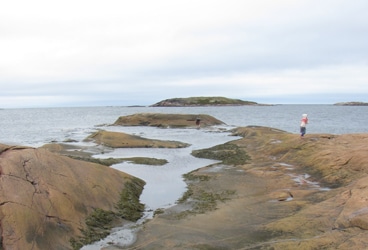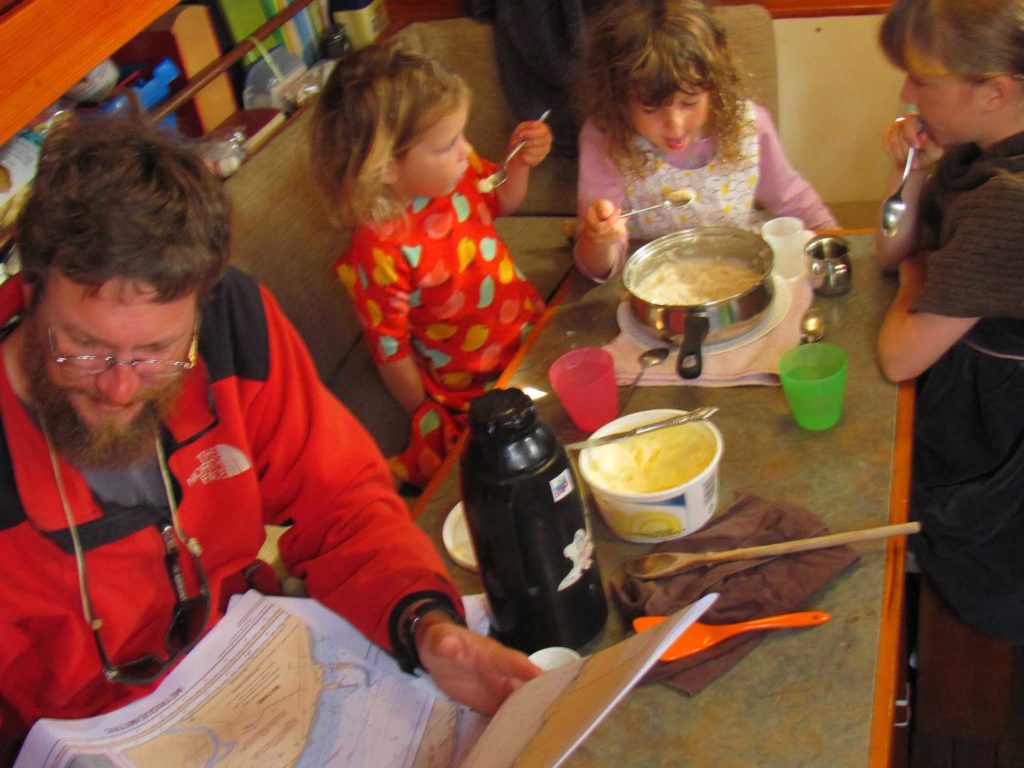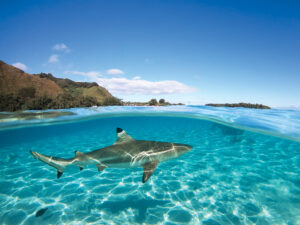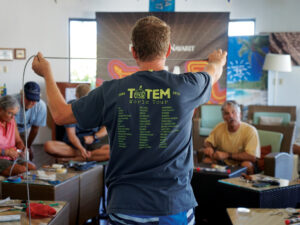
Natashquan, Quebec, was until very recently the literal end of the road. Though it now goes a few miles further to Kegaska, for many years the highway connecting that part of the coast to the rest of the world stopped there, making a very obvious demarcation between between French-speaking Quebec and it’s English-speaking outports. While cruising among the scattered settlements, we had met only one person who didn’t speak exclusively English—all the people on that inaccessible coast are essentially Newfoundlanders: same ancestors, same accent, same outlook on life. I had expected a gradual ease, then, into French-speaking waters, and was startled to find in Natashquan not a soul who understood English—not even enough to convey basic words like “boat” and “gasoline”. Luckily, these were two French words I had learned back in St. Pierre and Miquelon, and I dredged them out of memory’s depths and put them to good use.
The first order of business, once we had tied up, was to untie again and shift to the north side of the huge steel wharf that dominates the harbor. This was because although it’s the windward side, the north face of the wharf gives some shelter from the perpetual swell that comes in from seaward, a swell that was running even though there had been no wind to generate it for days. Some places are just like that—it was like being on the Pacific coast of Central America, in a perpetual swelly calm.
Things were a little better after we moved, though the surge was still considerable. It took some getting used to, to see the rusty side of the wharf flying past the portholes, then to hear the creak and pop as the docklines stretched bowstring-tight, followed by the wharf shooting back the other way as the lines sprang back. It was hard on fenders, it was hard on nerves, and mostly it was hard on lines. Our poor frayed docklines, that had already been through two winters of ill-sheltered marinas, had suffered much from jagged-edged commercial wharves this summer, and the one at Natashquan was the worst of them all. It was also the hardest to get onto from the boat, not only because you had to catch the rungs of an inset ladder as the boat shot by, but then climb it for a long way before crawling around the overhanging edge at the top. The children had to be sent up one by one with someone aloft to receive them and someone below in case they fell. All that swinging and climbing they always do in the rigging now paid off though, and they nimbly got on and off the boat without mishap.
Given it’s road access to everywhere (“You could drive from here all the way to Panama!” Danielle told the girls), we had been looking forward to a good grocery store, and were not disappointed. Though it was rather far away, there was better selection and prices and than we’d seen since St. Anthony. The price of gas, also, dropped from an outrage to merely astronomical.
We left early on the second morning after arriving, with a stiff offshore breeze on the beam driving Ganymede swiftly along the shoal-fretted coast toward the Mingan Archipelago. It was again a long haul, but time passes quicker when you’re sailing instead of motoring, and we reveled in the speed even as we shivered in the chilly north wind.
Things were warmer that evening when we anchored by the deserted Ile St-Genevieve, and warmer still next day as we carried on the last few miles to Havre-St-Pierre. This was the first big-ish city along the coast, and we’d decided to splurge on staying at the marina, which purported to have showers and laundry.
But after we had tied up to a (luxury!) floating pier inside the breakwaters, our hopes of showers and laundry were dashed. It was too late in the season, and the marina was not staffed. But there was electricty still, and water, and we rejoiced in topping up our drinking water and taking sponge-baths in Ganymede’s wood-heated cabin.
There is a splendid beach several miles long at Havre-St-Pierre, and notwithstanding the cold, the girls spent a day playing in the sand while I ran errands in the scattered town. There were two days of west wind in the forecast, and we were glad to have an excuse to sit tight and rest. After all, we had got around Cape Whittle, past Natashquan and fairly into the western Gulf of St. Lawrence. Now there was just the St. Lawrence river to negociate, followed by the Chambly Canal which would lead us to Lake Champlain at the US-Canada border and we’d be in home waters. Piece of cake—or it would have been if the Coast Guard captain I was talking to hadn’t mentioned that the Chambly Canal locks would close in fifteen days.

Fifteen days! I had thought we had a comfortable month and a half to get there. All relief and restfulness vanished as Danielle and I pulled out charts and dividers and paced off distances again and again. We would have to make thirty miles a day, every single day, to barely make it on time. Well and good, if the weather cooperated—we could easily do a couple of longer days and earn a breather. But the weather was not cooperating just now, and could possibly fail to cooperate at any critical juncture ahead. That was far too fine a thread to hang such weighty hopes upon. To not make it, and have to store the boat in Canada for the winter, had been a spectre looming large since we were in Newfoundland. We had caught, time after time, what proved to be the last good weather window of the season: though the Straits; around Cape Whittle; out of Natashquan: if we’d missed any of those, the weather that had immediately followed in those places would have left us no choice but to seek a place to haul Ganymede out until spring. We had cut it too fine for comfort already. The spectre now loomed even larger, and though it would do as a last resort, the expense and logistical nightmare of it made any other option worth trying first.
“There’s nothing for it,” I said at last, letting the dividers drop onto the much-punctured chart. “We’ll have to go day and night whenever wind and tide allow, and get whatever rest we can between times.”
“We’ve done it before,” said Danielle.
“Not like this. It’s really cold at night, and we’ve got to play some major tides in the river, and there’ll be a frightful lot of shipping.” I dug my fingers hard into my hair. “It’ll probably be the toughest run we’ve ever done.”
“If we have no choice, I guess I’m game,”
I looked up from the chart. She was game; she always has been. Good for her. The race was on.
We are the Zartman family: Ben & Danielle, and our three girls, Antigone, Emily and Damaris. We created this blog to chronicle our sailing adventures on Ganymede, a home-finished 31-foot gaff-rigged cutter, which has been our home since 2009, when we sailed from San Francisco, California, to the Sea of Cortez, then down along the Central American coast.








